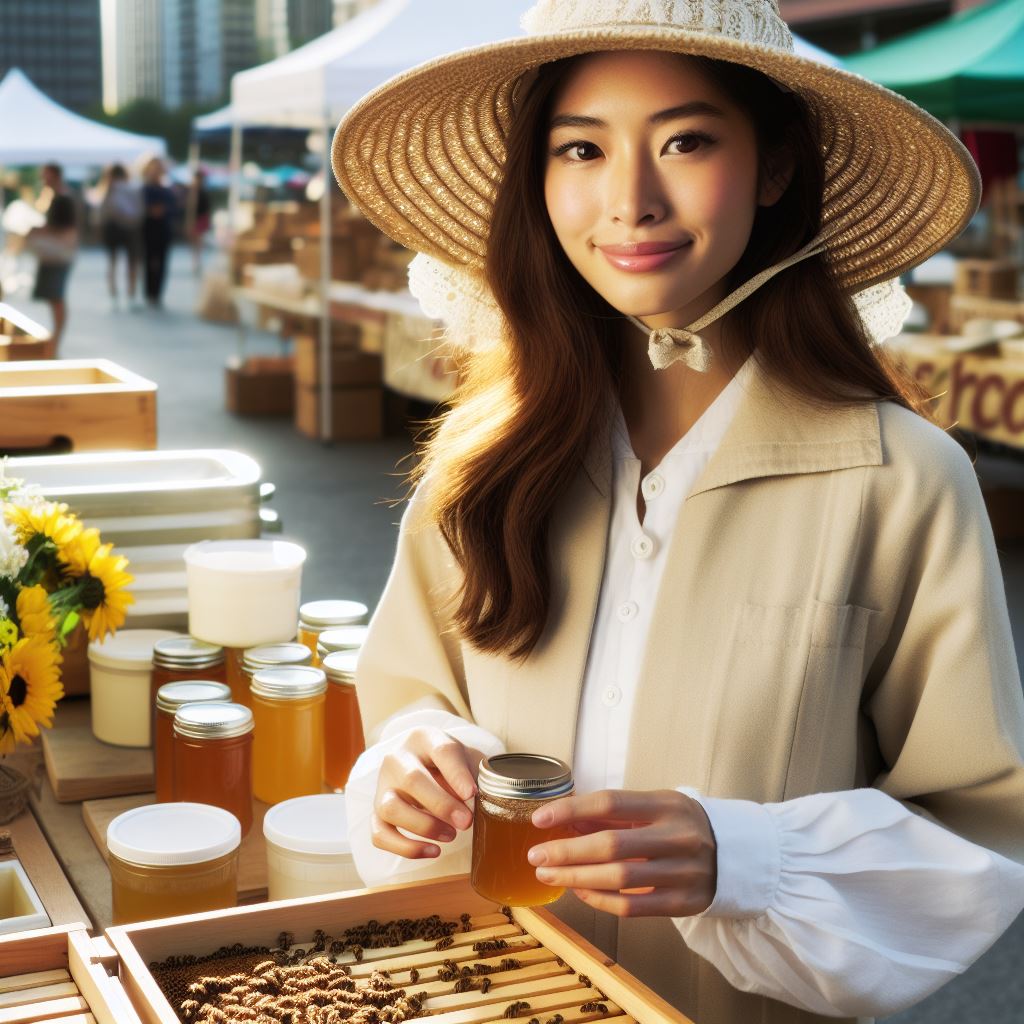Urban Beekeeping: A Farm-to-Table Buzz
Last Updated on February 4, 2024
Introduction
Urban beekeeping refers to the practice of raising bee colonies in cities and urban areas.
It has gained significant popularity in recent years, as people have become more interested in sustainable and local food sources.
By keeping bees in urban environments, individuals contribute to the farm-to-table movement in a unique and vital way.
One of the main reasons urban beekeeping is significant in the farm-to-table movement is because it promotes sustainability.
Bees play a crucial role in pollinating flowers, fruits, and vegetables, ensuring the growth and reproduction of plants.
By maintaining bee colonies in urban areas, we help maintain a healthy ecosystem and ensure the availability of wholesome, organic produce.
Another key benefit of urban beekeeping is its support of local agriculture.
Bees are essential for the pollination of crops, which are often located in rural areas.
However, transporting beehives over long distances can be stressful for the bees and detrimental to their health.
By keeping bees in urban areas, we minimize the need for long-distance transportation and promote local agriculture.
Furthermore, urban beekeeping provides access to natural, high-quality honey.
Unlike commercially produced honey, which often undergoes extensive processing and may contain additives, honey from urban beekeeping is typically pure and unprocessed.
The bees collect nectar from a variety of urban plants, resulting in honey with unique flavors and characteristics.
This direct access to local honey enhances the farm-to-table experience by providing consumers with a wholesome and flavorful product.
In summary, urban beekeeping is a growing trend that enhances the farm-to-table experience.
It promotes sustainability by ensuring pollination of urban plants, supports local agriculture by reducing the need for long-distance transportation, and provides consumers with natural, high-quality honey.
By participating in urban beekeeping, individuals actively contribute to a more sustainable and wholesome food system.
Benefits of Urban Beekeeping
Urban beekeeping not only brings the amazing buzz of honeybees to the city, but it also offers a myriad of benefits for urban areas and their residents.
By enhancing pollination and biodiversity, supporting local agriculture, boosting urban gardens, and providing access to fresh honey, urban beekeeping has become a farm-to-table trend that is positively transforming urban spaces.
Enhances Pollination and Biodiversity in Urban Areas
With the decline of global bee populations, urban beekeeping plays a crucial role in the pollination of urban flora.
These hardworking bees ensure the successful fertilization of flowers, allowing plants to produce fruits, vegetables, and seeds.
As a result, urban beekeeping supports the growth of a diverse range of plants, enhancing biodiversity in concrete jungles.
Supports Local Agriculture by Increasing Crop Yield and Quality
Bees are nature’s best pollinators, and urban beekeeping helps revitalize local agriculture by ensuring a higher crop yield and improved crop quality.
Pollination by bees contributes to the growth, development, and reproduction of flowering crops.
This, in turn, increases the overall productivity of urban farms and community gardens, supporting the local food system.
Boosts Urban Gardens and Community-Supported Agriculture (CSA) Programs
Urban beekeeping presents a unique opportunity to foster community-supported agriculture programs and urban gardens.
By introducing beehives in these spaces, beekeepers can collaborate with gardeners, sharing knowledge and resources.
The bees’ pollination services not only benefit the gardens but also strengthen the community bonds as people come together with a shared interest in sustainable food production.
Provides Urban Residents with Access to Fresh, Natural Honey
- Beyond the valuable pollination services, one of the sweetest benefits of urban beekeeping is the production of fresh, natural honey.
- Urban residents can enjoy the taste and health benefits of locally sourced honey, knowing exactly where and how it was produced.
- Local honey is known to contain traces of local allergens, helping build resistance to seasonal allergies.
In short, urban beekeeping brings a multitude of benefits to both urban areas and their residents.
By enhancing pollination, supporting local agriculture, boosting urban gardens, and providing access to fresh honey, urban beekeeping buzzes with positivity, nourishing both people and the environment.
Read: The Rise of Micro-Farming in Cities
The Basics of Urban Beekeeping
Space and Equipment Requirements for Urban Beekeeping
- Bees can thrive in small spaces like balconies, rooftops, or even small backyards.
- To start beekeeping, you’ll need a beehive, frames, a smoker, a hive tool, and protective clothing.
- Ensure your space has enough flowers and plants nearby to provide a good source of nectar and pollen.
- Consider the weight of the hive and make sure your space can support it safely.
Legal Considerations and Permits Needed in Urban Areas
- Check with your local city council or municipality about any regulations or restrictions on beekeeping.
- Some cities may require permits or licenses for beekeeping to ensure safety and proper management.
- Familiarize yourself with any zoning laws that might affect beekeeping activities in your area.
- Be a responsible beekeeper and respect your neighbors’ concerns and any legal requirements.
Importance of Proper Hive Management and Maintenance
- Regular inspections are crucial to ensure the health and productivity of your bee colony.
- Monitor the hive for signs of disease or pests and take appropriate action if necessary.
- Properly feeding the bees during periods of low nectar flow is important for their survival.
- Maintain cleanliness and good hygiene practices to prevent the spread of diseases within the hive.
Safety Measures for Beekeepers, Neighbors, and Visitors
- Always wear protective clothing including a beekeeping suit, gloves, and a veil to prevent stings.
- Place your beehive in a well-ventilated area away from high-traffic zones to minimize disturbances.
- Educate your neighbors about beekeeping and address any concerns they may have.
- Put up signs and barriers to alert visitors to the presence of bees and prevent accidental encounters.
In essence, urban beekeeping can be a rewarding and sustainable practice, but it requires careful planning, adherence to regulations, and responsible hive management.
By providing bees with a suitable environment and ensuring the safety of beekeepers, neighbors, and visitors, urban beekeeping can contribute to the health of local ecosystems and provide fresh, local honey to urban dwellers.
Read: Urban Farms: Revolutionizing Local Food
Setting Up an Urban Beekeeping Operation
Setting up an urban beekeeping operation requires careful planning and consideration.
Here are some key steps to follow:
Identifying suitable locations for urban beehives
- Look for areas with abundant floral resources, such as gardens, parks, or rooftops.
- Avoid placing beehives near areas with high foot traffic to minimize disruptions and potential stings.
- Ensure there is enough space for the hives and that they comply with local regulations.
Selecting the right honeybee breeds for urban environments
- Choose honeybee breeds that are well-suited for urban areas, such as Carniolan or Italian honeybees.
- Consider their adaptability to varying climates and their gentle behavior, which is important in busy urban environments.
- Consult local beekeeping associations or experts for recommendations on suitable breeds.
Sourcing honeybees and acquiring a starter colony
- Find reputable bee breeders or local beekeeping associations to purchase honeybees from.
- Consider buying a nucleus colony, which consists of a queen and several worker bees, to start your hive.
- Ensure the bees are healthy and disease-free by inspecting them or seeking professional advice.
Cultivating a bee-friendly environment through plant selection
- Plant a diverse range of flowers, herbs, and trees that provide a continuous source of nectar and pollen.
- Choose native or non-invasive species that are known to attract pollinators and thrive in your area.
- Avoid using pesticides or herbicides that could harm bees and other beneficial insects.
By following these steps, you can create an ideal environment for your urban beekeeping operation.
Remember to stay informed about local regulations and seek advice from experienced beekeepers to ensure a successful and sustainable endeavor.
Read: City Rooftop Gardens: Farm-to-Table Stars
Urban Beekeeping as a Sustainable Practice
Urban beekeeping has gained popularity as a sustainable practice with several beneficial impacts:
Reducing Environmental Impact through Pollination and Biodiversity
Urban areas often lack sufficient natural pollinators, posing a challenge to urban gardens and green spaces.
By introducing beehives, urban beekeepers help ensure proper pollination of plants, leading to healthier yields and increased biodiversity.
Bees are known to pollinate a wide variety of flowering plants, helping those that would otherwise struggle due to limited insect activity.
Decreasing Reliance on Industrial Beekeeping and Transportation
Traditional beekeeping practices involve large-scale operations and the transportation of beehives across long distances to satisfy the pollination needs of agricultural crops.
This transportation can stress bees and make them more susceptible to diseases and pests.
Urban beekeeping reduces our reliance on these industrial practices, allowing bees to thrive in their natural habitat.
Encouraging the Use of Natural Alternatives to Chemical Pesticides
Chemical pesticides used in agriculture have adverse effects on both honeybees and native bee populations.
Urban beekeeping promotes the use of natural pest control methods, such as introducing predator insects, companion planting, and cultural practices.
By avoiding chemical pesticides, urban beekeepers create a safer environment for both bees and humans.
Utilizing Rooftop Gardens and Unused Urban Spaces for Beekeeping
- Urban areas have limited space, but urban beekeepers have found innovative ways to establish beehives.
- Rooftop gardens, balconies, and even unused alleys or abandoned lots serve as ideal locations for beehives.
- These spaces not only provide a suitable habitat for bees but also contribute to local honey production and encourage community involvement in sustainable practices.
Generally, urban beekeeping emerges as a sustainable practice with various environmental benefits.
Through pollination and increased biodiversity, it enhances the overall health of urban ecosystems.
By reducing reliance on industrial beekeeping and promoting natural alternatives to chemical pesticides, it protects both bees and the environment.
Lastly, by efficiently utilizing unused urban spaces, it maximizes the potential for creating bee-friendly habitats. Urban beekeeping truly buzzes with sustainable potential.
Read: Cooking with CSA Veggies

Challenges and solutions for urban keepers
Urban beekeeping has gained significant popularity in recent years, bringing the farm-to-table concept to cities.
However, this endeavor is not without its challenges.
In this section, we will explore the various obstacles faced by urban beekeepers and the innovative solutions they have developed
Dealing with limited forage availability in urban settings
- Limited green spaces: Urban beekeepers must find creative ways to provide their bees with sufficient forage. Utilizing rooftops, balconies, and community gardens as bee-friendly spaces can maximize forage opportunities.
- Sourcing diverse nectar and pollen: Urban beekeepers face the challenge of offering a varied diet to their bees due to limited plant diversity. Collaborating with nearby farmers and planting diverse flowers can help address this issue.
- Educating the public about urban pollinator-friendly plantings: Raising awareness among the community about the importance of planting bee-friendly flowers can increase forage availability. Partnering with local schools and organizations to create educational programs can promote the concept of urban pollinator gardens.
Managing potential conflicts with neighbors and public perception
- Addressing concerns about stings and safety: Urban beekeepers need to educate their neighbors about the docile nature of honeybees and address concerns about stings. Sharing information on beekeeping best practices and inviting neighbors to observe hive inspections can foster understanding and trust.
- Mitigating the risk of swarming: Swarms can be alarming to the public and may lead to negative perceptions of urban beekeeping. Regular hive inspections and providing ample space for bee colonies can help prevent swarming and maintain overall hive health.
- Encouraging responsible hive management: Urban beekeepers should adhere to local regulations and guidelines to maintain positive public perception. Demonstrating good beekeeping practices and involving neighbors in hive maintenance can help build support within the community.
Addressing pests and diseases in urban beehives
- Varroa mites and other bee pests: Urban beekeepers face similar pest challenges as their rural counterparts, including Varroa mites. Regular monitoring, treatment, and collaborating with local beekeeping associations can help manage pests effectively.
- Maintaining colony health: Frequent hive inspections and proactive disease management protocols are vital for maintaining healthy urban bee colonies. Educating beekeepers about common diseases and encouraging them to participate in workshops can improve colony health.
Seeking out community resources and support networks
- Joining local beekeeping associations: Becoming a member of beekeeping associations provides urban beekeepers with valuable resources, mentorship, and networking opportunities. Attending meetings, workshops, and conferences can enhance beekeeping skills and facilitate knowledge exchange.
- Collaborating with urban agriculture initiatives: Building partnerships with urban agriculture projects can create symbiotic relationships that benefit both beekeepers and urban farmers. Sharing resources, organizing joint events, and exchanging expertise can foster a thriving urban farming community.
Basically, urban beekeepers face unique challenges that require creative thinking and collaboration.
By addressing limited forage availability, managing conflicts, combating pests and diseases, and seeking community resources, these dedicated beekeepers are finding innovative solutions to sustain their hives and contribute to the urban ecosystem.
Harvesting and Using Urban Honey
Timing and methods of honey extraction
- Determine the right time to harvest honey by observing the ripeness of the combs.
- Use a honey extractor to spin the frames and extract honey without damaging the comb.
- Filter and strain the extracted honey to remove any impurities and obtain a smooth consistency.
Proper processing and storing of urban honey
- Allow the freshly extracted honey to settle for a day to remove air bubbles.
- Store the honey in clean glass jars or containers with tight lids to prevent moisture absorption.
- Keep the honey in a cool, dark place away from sunlight and heat to maintain its quality and freshness.
Utilizing urban honey in farm-to-table cuisine and recipes
- Use urban honey as a natural sweetener in a variety of dishes such as dressings, marinades, and desserts.
- Incorporate urban honey into homemade bread, pastries, and granola bars for a unique flavor twist.
- Experiment with honey-infused beverages like herbal teas, cocktails, or honey-based syrups for drizzling over pancakes.
Marketing and selling urban honey as a local, sustainable product
- Create a brand and label for the urban honey to highlight its origin and sustainable production.
- Participate in local farmers’ markets or food festivals to showcase and sell the urban honey.
- Develop partnerships with nearby restaurants, bakeries, or specialty food stores to feature and promote the honey.
Therefore, harvesting urban honey requires careful timing and proper methods of extraction to ensure the best quality product.
Once harvested, the honey should be processed, stored, and utilized in various farm-to-table recipes.
Lastly, marketing and selling urban honey should focus on promoting its local and sustainable characteristics to attract customers who value supporting sustainable food practices.
Conclusion
Urban beekeeping has emerged as an essential component of the farm-to-table movement, offering numerous benefits and significant contributions.
By keeping bees in urban areas, we can promote the sustainability of our food systems and support local agriculture.
Throughout this blog chapter, we have explored the various advantages that urban beekeeping brings.
Not only does it provide urban residents with access to fresh, locally-produced honey, but it also enhances pollination in gardens and green spaces, improving the overall quality of urban biodiversity.
As we have seen, urban beekeeping is not just reserved for rural areas; it is a viable and sustainable hobby that urban residents can undertake, regardless of limited space.
By taking up beekeeping, individuals can play an active role in preserving these vital pollinators and making a positive impact in their community.
Supporting local agriculture is crucial in maintaining a healthy and sustainable food system.
Urban beekeeping allows us to connect with local farmers and support their efforts in providing fresh, organic produce.
By doing so, we contribute to the preservation of urban biodiversity, ensuring a harmonious coexistence between humans and nature.
Urban beekeeping is a farm-to-table buzz that everyone should be a part of. It benefits not only our environment but also our health and local economy.
So, let’s grab those beekeeping suits, set up our hives, and join the movement!


